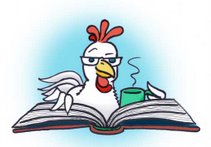Ten or fifteen years ago, when I worked at a progressive preschool, we used to cross out the sexist language in the older picture books (our own, naturally; not the library's) and rewrite it so that the kids we worked with would grow up knowing that girls can be police officers and firefighters and mail carriers, and fathers can take care of babies, and also that, incidentally, animals come in both the male and female variety.
That last point is surprisingly slow to catch on, even yea unto this day. In the last couple of weeks I've found myself reading two different otherwise-lovely picture books--both published within the past three years--that feature a variety of different animals, all of which (whom?) are inexplicably referred to as "he." After some pages of this my feminist training kicked in, and I started changing some of the "he"'s to "she," stopping momentarily to explain that this wasn't exactly how the author had written it, but I was reading it a little differently because some animals are girls, aren't they?
It might seem like a minor thing, but as a very girly girl growing up, I never felt for animal books, mainly because they all seemed somehow too boy-y. If a fictional animal was clearly a girl I was much more interested, but that was pretty unusual--in fact, except for the dragon in My Father's Dragon, and that whiny Little Red Hen--oh, and Kanga--I can't remember a single one.
How refreshing, then, to open up Mrs. Chicken and the Hungry Crocodile, (reviewed more fully here by a wrung sponge) a charming trickster tale from Liberia in which both the trickster and the tricked are most definitely women. Of course, they'd have to be, as the plot revolves around the hatching of their eggs.
Even so, the kindergarteners and even the first graders were confused; they kept pointing to the Hungry Crocodile and saying things like "He wants to eat that chicken up!"
Well. Apparently the revolution has not yet arrived. Onward, ye writers of animal picture books!
p.s. Come to think of it, that most popular of contemporary animal characters, the Pigeon, is never referred to (at least not in the books themselves) as either "he" or "she." Though it seems to be generally assumed that the Pigeon is male. I tried thinking of the Pigeon as a girl pigeon, and felt my brain's eyes cross with the effort.
Subscribe to:
Post Comments (Atom)

8 comments:
Hi Els,
I know what you mean about pronouns--I do it too. But I have a vauge feeling that there are lots and lots of female chicken characters out there--Hilda Hen and Lottie come to mind. I also have the feeling that in non- fiction videos there are more female animals than male, for what that's worth...
I guess there are a fair number of female chickens out there in picture-book land, now that I think of it. And there are lots of girl animal characters like Martha the dog and Frances the...hedgehog(?) and Zelda and Ivy, who are foxes, and that pig in Hog-Eye.
What I'm thinking of more are the sort of general animal characters who populate picture books in sort of walk-on roles: you know, like when one animal after another is fooled by Anansi, or insists that the sky isn't falling. They all tend to be male. It's not the most urgent issue in the universe, but it's a persistent annoyance.
In Eastern Eurpoean immigration stories, on the other hand, the protagonists are almost invariably female. To go by those books, the Lower East Side circa 1910 must have been populated entirely by plucky 12-year-old girls in babushkas. But that's a post for another day.
Frances is a badger!:) I think the hedgehog appears somewhere in a Beatrix Potter book.
A lot of the folktales I find with animal protagonists are called "he." I often change the sexes of the animals if the change enhances the story but doesn't mess with the cultural significance. One example is the Iroquois "Rabbit and Fox" from The Boy Who Lived with the Bears (Bruchac). Once Rabbit became female, the story was about a female trickster outwitting a hungry male.
It's been my experience that with kids the assumption of gender has partly to do with perceptions of the characteristics of that animal. If the animal in question is generally perceived as scary or violent -- alligator, bear, dinosaur -- children tend to assume it is male. baby animals without gender specific names tend to be assumed to be female, like chicks and bunnies and sheep.
I've always loved that Bambi is the name of a male deer but that it's origin is female in Italian.
I think many kids books and movies use a male character because the feeling is that girls will read/watch something where the main character is a boy, but boys will not read/watch something where the main character is a girl.
I don't know if it is that meaningful in preschool books, though.
Oh, and I love that Mrs. Chicken book. I just read it to my 2nd graders class last week - after being reminded of its existence by the Wrung Sponge blog.
Yes we loved Mrs. Chicken! The kids clapped after I read it. Paye is a wonderful storyteller.
Oh good grief, is that still going on? I thought they had finally gotten the memo.
Candlewick published an author who specifically had all her animal-people be female just to counteract that problem, but I can't remember now how it was...
Animals apart, I've always felt that kid lit is girl-centric, I'm talking about fairytales. But it is a good idea to introduce kids to the idea of male and female co-existing in story books too. Kids only grow up to be what they are told and if we can instil a sense of equality early on, the world will be a better place.
BlueRectangle Books
Post a Comment